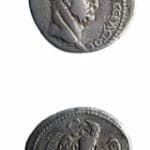Provincial Silver Tetradrachm of Emperor Galba, 68 CE - 69 CE
Silver
C.4266
Obverse: Laureate Bust of the Emperor Facing Righ Reverse: An Eagle Standing to the Left, Holding a Thunderbolt in its Talons, a Long Palm Frond to the Left Servius Sulpicius...
Obverse: Laureate Bust of the Emperor Facing Righ
Reverse: An Eagle Standing to the Left, Holding a Thunderbolt in its Talons, a Long Palm Frond to the Left
Servius Sulpicius Galba served most of his political life as a distinguished Senator under the Julio-Claudian line of emperors dating from the time of Augustus. Under Emperor Nero, he was appointed governor of Spain in 60 A.D. However, by 67 A.D., the Senate had grown tired of Nero’s rule and popular revolts broke out in the provinces, first in Gaul, then in Spain under Galba’s authority. When Galba intercepted a letter from Nero to one of his Spanish agents ordering his arrest, Galba allowed his soldiers to declare him Imperator on April 2, 68 A.D at the ripe old age of seventy-three. The Senate confirmed Galba as Augustus upon Nero’s flight and suicide. Yet Galba proved to be an ineffective ruler whose pride stood in the way and invoked the wrath of those closest to him. He alienated both the army and the Praetorian Prefect when he refused to pay them bonuses upon his ascension which was customary whenever a new emperor took the throne. Later, he fired the Praetorian Prefect who had bribed the Guard away from Nero and aided in Galba’s revolt, famously declaring, “it is my policy to levy troops, not to buy them.” Finally, he committed one last fatal blunder when he declared a young nobleman, Calpurnius Piso Licianus, to be his heir. Piso had no military experience and has disdained by the Praetorian Guard. Worse, this offended Otho who expected to succeed Galba. Otho then declared himself Emperor and led a calvary that slaughtered Galba in the streets of the Forum on January 15th, 69 A.D. In the end, Galba served as Emperor for only seven months.
How many hands have touched a coin in your pocket or purse? What eras and lands have the coin traversed on its journey into our possession? As we reach into our pockets to pull out some change, we rarely hesitate to think of who might have touched the coin before us, or where the coin will venture to after it leaves our hands. More than money, coins are a symbol of the state that struck them, of a specific time and location, whether contemporary currencies or artifacts of a long forgotten empire. This stunning hand-struck coin reveals an expertise of craftsmanship and intricate sculptural detail that is often lacking in contemporary machine-made currencies. This ancient coin is an intimate memorial to Galba, passed from the hands of civilization to civilization, from generation to generation that still appears as vibrant today as the day it was struck.
Reverse: An Eagle Standing to the Left, Holding a Thunderbolt in its Talons, a Long Palm Frond to the Left
Servius Sulpicius Galba served most of his political life as a distinguished Senator under the Julio-Claudian line of emperors dating from the time of Augustus. Under Emperor Nero, he was appointed governor of Spain in 60 A.D. However, by 67 A.D., the Senate had grown tired of Nero’s rule and popular revolts broke out in the provinces, first in Gaul, then in Spain under Galba’s authority. When Galba intercepted a letter from Nero to one of his Spanish agents ordering his arrest, Galba allowed his soldiers to declare him Imperator on April 2, 68 A.D at the ripe old age of seventy-three. The Senate confirmed Galba as Augustus upon Nero’s flight and suicide. Yet Galba proved to be an ineffective ruler whose pride stood in the way and invoked the wrath of those closest to him. He alienated both the army and the Praetorian Prefect when he refused to pay them bonuses upon his ascension which was customary whenever a new emperor took the throne. Later, he fired the Praetorian Prefect who had bribed the Guard away from Nero and aided in Galba’s revolt, famously declaring, “it is my policy to levy troops, not to buy them.” Finally, he committed one last fatal blunder when he declared a young nobleman, Calpurnius Piso Licianus, to be his heir. Piso had no military experience and has disdained by the Praetorian Guard. Worse, this offended Otho who expected to succeed Galba. Otho then declared himself Emperor and led a calvary that slaughtered Galba in the streets of the Forum on January 15th, 69 A.D. In the end, Galba served as Emperor for only seven months.
How many hands have touched a coin in your pocket or purse? What eras and lands have the coin traversed on its journey into our possession? As we reach into our pockets to pull out some change, we rarely hesitate to think of who might have touched the coin before us, or where the coin will venture to after it leaves our hands. More than money, coins are a symbol of the state that struck them, of a specific time and location, whether contemporary currencies or artifacts of a long forgotten empire. This stunning hand-struck coin reveals an expertise of craftsmanship and intricate sculptural detail that is often lacking in contemporary machine-made currencies. This ancient coin is an intimate memorial to Galba, passed from the hands of civilization to civilization, from generation to generation that still appears as vibrant today as the day it was struck.
1
of
2



